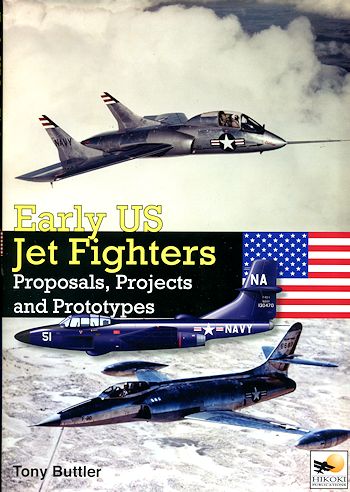 We now
have another great Hikoki book on prototype, research and production aircraft.
This volume is on early US jet fighters and covers a period from the end of the
war until around the mid 1950s. This was a time when there was much new in
aviation and the development of turbine and rocket power allowed what is
probably the greatest growth in the parameters of military aircraft.
We now
have another great Hikoki book on prototype, research and production aircraft.
This volume is on early US jet fighters and covers a period from the end of the
war until around the mid 1950s. This was a time when there was much new in
aviation and the development of turbine and rocket power allowed what is
probably the greatest growth in the parameters of military aircraft.
When you think a subject has already been covered before, along comes a
book that puts things into a new and interesting light. Rather than just a
listing of aircraft types, this one looks at design requests, covering all of
the proposals that led to a final decision of some sort. Both US Army/USAF and
Navy projects are covered.
Let me give you a 'for instance'. One proposal
was for a US Navy night fighter that was drawn up in June of
1945 and sent to manufacturers a few months later. Specs for this aircraft were
a 475 mph speed at 45,000 feet and the ability to intercept an enemy at 125
miles at 40,000 feet. Combat radius had to be 350 nm and an initial rate of
climb was to be 3,500ft/min. The aircraft had to operate in all weather
conditions and be able to destroy surface targets as well. Quite a task for
mid-1945.
Several proposals were put through, all of them straight wing designs.
Bell put forth the model D-31 powered by two turboprops out near the end
of the wings. Chance-Vought proposed the V-343 in both turbojet and turboprop
designs. Convair had the model 4505, a jet powered aircraft while Curtiss-Wright
proposed a turboprop aircraft. Douglas offered several designs under the D-561
designator and Goodyear offered the GA-13 turboprop design. Grumman offered a
Model 75 with four jet engines. The winning designs were by Douglas and by
Grumman. I was surprised at how similar the airframes were in all of the designs
(at least in this instance as others had wildly varying offerings for the same
spec). Eventually, the Douglas design won the contract to become the F3D
Skyknight.
Each of the various design sections, and there are a dozen of them,
includes not only a description of each proposal, but the design specs hoped for
by the designs of each manufacturer. This is accompanied by factory drawings and
sometimes models of the projects that did not make into mockup. Sometimes
several projects were chosen and so there would be mockups of the aircraft. Some
had several planes make it into prototype form. And sometimes, there was a fly
off and none of the proposals was accepted for production. This often happened
when it became clear that the proposal was too advanced or the requirement had
disappeared.
Chock full of great period photographs, the book is an outstanding look
at what used to be the way that military aircraft were designed and decided.
Today, things have changed a great deal. There are no more prototypes with the
chosen design based more on politics than on capabilities. Witness the current
debacle regarding the F-35 as a prime example of this.
The book is a must have for the enthusiast of '50s aircraft and deserves
a place on the shelf of anyone interested in the fascinating designs of the
forties and fifties. Most highly recommended.
October 2013
Review book courtesy of
Specialty Press,
where you can order your copy of this and many other superb aviation and
modeling books. Visit their website at the link above or call them at
1-800-895-4585. Shipping and handling is $6.95
If you would like your product reviewed fairly and
fairly quickly, please contact
me or see other details in the
Note to
Contributors.
 We now
have another great Hikoki book on prototype, research and production aircraft.
This volume is on early US jet fighters and covers a period from the end of the
war until around the mid 1950s. This was a time when there was much new in
aviation and the development of turbine and rocket power allowed what is
probably the greatest growth in the parameters of military aircraft.
We now
have another great Hikoki book on prototype, research and production aircraft.
This volume is on early US jet fighters and covers a period from the end of the
war until around the mid 1950s. This was a time when there was much new in
aviation and the development of turbine and rocket power allowed what is
probably the greatest growth in the parameters of military aircraft.